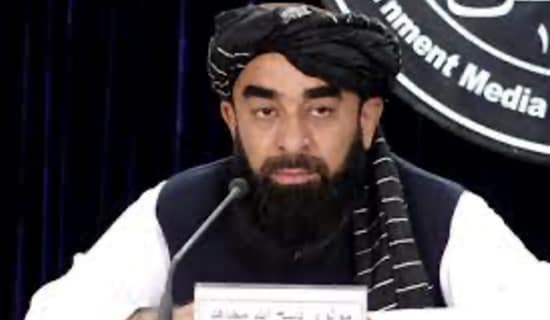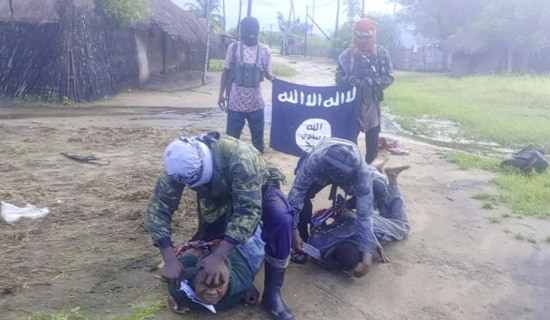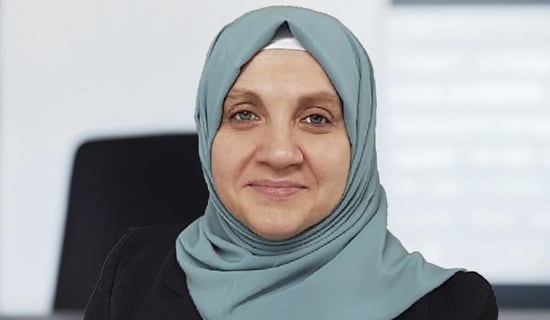The following is the "Democratic Transitional Plan for Iran," written by the Free Balochistan Movement, headed by Hyrbyair Marri. The transitional plan has been presented by the Free Balochistan Movement to other ethnic groups present in Iran, such as Kurds, Ahwazis, and Azeris. At the moment, this is the only plan that finds a broad consensus.
The plans states: "The current Iranian theocratic regime is facing civil resistance from both Persians and non-Persians. Armed national insurgent groups, such as those in Kurdistan and Balochistan, seek to overthrow the regime and regain their independence. But imagine if the regime were to fall today – what would happen next?
"Would the Balochs, Kurds, Arabs, and Turks engage in conflict with a post-Mullah Iran? Would a new regime use the military to suppress civilian movements for independence in Balochistan, Kurdistan, Al-Ahwaz, and Turkic Azerbaijan? Would Iran once again descend into a protracted conflict? Could Persians resort to ethnically cleansing non-Persian regions and resettling those areas with their own population?
"The best way to resolve this issue and avoid internal conflict in Iran is through a Democratic Transitional Plan for Iran."
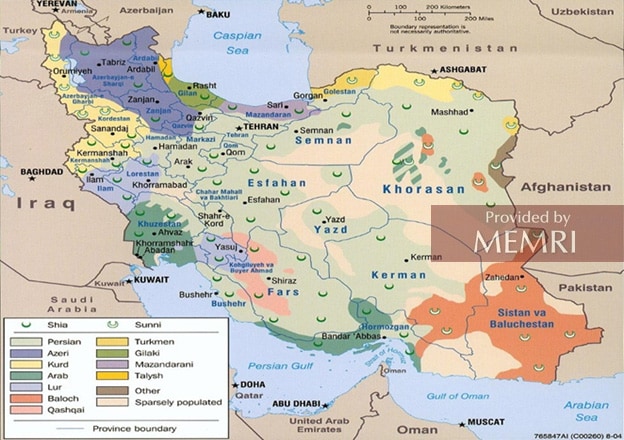
The map shows current provinces within Iran and the population of different national groups. (Source: CIA)
Following is the full text of the "Democratic Transitional Plan for Iran:"
Introduction
Iran, known as Persia or the Persian Empire until 1935 in the Western world, is a modern colonial geopolitical construct. Its current boundaries encompass Persians, Balochs, Kurds, Turks, Arabs, and the territories of other historical nations. "Iranian" and "Persian" are synonyms often used interchangeably. However, anthropologically, Iranian nationality and Iranic people as ethno-linguistic groups are distinct. Modern Iranic peoples include Balochs, Kurds, Lurs, Mazanderanis, Ossetians, Tats, Tajiks, Talysh, Pashtuns, Pamiris, Persians, Yaghnobis, Wakhis, and Gilaks. They inhabit the Iranian Plateau, a geopolitical region spanning parts of modern-day Afghanistan, Azerbaijan, Iran, Iraq (Iraqi Kurdistan), Pakistan (Khyber Pakhtunkhwa and occupied Balochistan), and Turkmenistan.
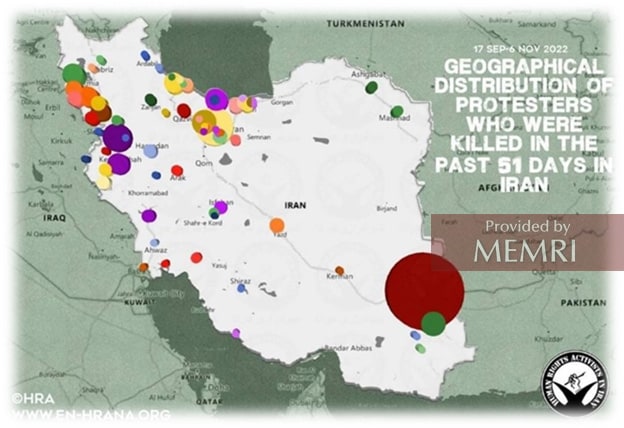
The map shows that Balochistan, Kurdistan, and Ahwaz in particular have faced brutal repression by Iranian security forces during the 2022 protests (from September 17 to November 6, 2022), compared to central Persian regions. (Source: En-hrana.org)
Iran/Persia
Historically, the Persians ruled the ancient Persian Empire until Alexander the Great defeated and conquered them. After Alexander’s death, it was ruled by his generals. Subsequently, several different Persian and non-Persian dynasties governed it during antiquity. However, following the Arab conquest, it was consistently controlled or ruled by non-Persian dynasties until Reza Mirpanj, a military officer, seized power with British assistance in the early 20th century and dissolved the Qajar Empire, which was originally a Turkic dynasty.
Reza Mirpanj, later known as Reza Pahlavi, with Western support, centralised modern-day Iran, suppressing the independence and autonomy of the non-Persian nations. Reza Pahlavi promoted Persian nationalism and claimed it was a continuation of the Persian Empire that existed in antiquity. Reza and his successor, Mohammad Reza, pursued policies of centralisation and Persianisation in modern-day Iran. These policies resulted in civil unrest, human rights violations, and political repression, ultimately leading to a revolution that was co-opted by the Shiite mullahs, as religious groups were more organised than political opposition groups. Since 1979, Iranian mullahs have controlled Iran. Although religious fundamentalists, they are as nationalist as the Pahlavi dynasty. They have continued the policies of Persianisation against non-Persian nations and have engaged in the ethnic cleansing of Baloch, Arab, Turk, and Kurdish populations.
Iran was never a single country during the modern era. It was always unified by force, driven by imperialist agendas that perceived Persians as the rulers not only of Persian lands but of the entire territory of Iran, which encompassed the historical lands of different nations. The age of empires ended long ago. The Persian undemocratic experiment is the reason why we have mullahs in power today. Therefore, any long-term solution to the Iranian problem must address the root cause of the issue: the creation of an empire in the age of nations.

Distribution of the Iranic nations in Asia. Iranic people speak Indo-Iranian languages within the Indo-European language family. (Source: Reddit)
Resolving The Root Cause
The root cause of the crisis in Iran is the imposition of Iran as a country on nations that do not wish to be part of it, have a history of unique statehood, or feel, due to historical injustices, that they cannot develop or succeed unless they are free nations, controlling their own destinies and making their own laws.
For example, some Persians favour a republic, while others support a monarchy. If the majority of Persians were to choose a monarchy, why should Kurds, Balochs, Arabs, and Turks be compelled to accept a Persian king as their ruler? The Persian majority overwhelmingly supported Khomeini during the 1979 revolution, thereby legitimising the theocratic regime. One of Iran's fundamental questions is whether Persians should impose their will and political decisions on other nations, or whether they should be solely responsible for their own political judgements and decisions. If it is wrong for one nation to impose its will on another, why should non-Persian nations suffer because of the political decisions made by Persians, as happened during Reza Shah’s 1921 coup d'état or the 1979 revolution, both of which brought misery and destruction to non-Persian nationalities?
Similarly, Balochs, Kurds, Turks, Arabs and other nations should have the right to national self-determination and be responsible for their own mistakes and successes as free nations. Most geographical nations, i.e., those that inhabit a homeland and are a majority in their historical territories, aspire to establish their own countries. They seek independent states such as Balochistan, Kurdistan, Turkic Azerbaijan, and Al-Ahwaz. A democratic solution would grant these nations their national rights and respect their aspirations for national liberation. However, these rights should be implemented within a specific timeframe to avoid chaos, anarchy, and instability. Additionally, this approach would ensure that the national question of non-Persian nations within Iran is resolved through democratic means and principles.
National Liberation Via A Democratic Route Is the Solution
The current Iranian theocratic regime is facing civil resistance from both Persians and non-Persians. Armed national insurgent groups, such as those in Kurdistan and Balochistan, seek to overthrow the regime and regain their independence. But imagine if the regime were to fall today – what would happen next?
Would the Balochs, Kurds, Arabs, and Turks engage in conflict with a post-Mullah Iran? Would a new regime use the military to suppress civilian movements for independence in Balochistan, Kurdistan, Al-Ahwaz, and Turkic Azerbaijan? Would Iran once again descend into a protracted conflict? Could Persians resort to ethnically cleansing non-Persian regions and resettling those areas with their own population?
The best way to resolve this issue and avoid internal conflict in Iran is through a Democratic Transitional Plan for Iran. Under such a plan, nations under Iranian/Persian occupation would not declare secession immediately, nor would Persians be allowed to dominate Iran as they did during the Pahlavi dynasty. This compromise would benefit all parties, aiming to secure peace, democracy, freedom, and national liberation.
Such a Democratic Transitional Plan would be a treaty with international guarantors. If Persia or any other entity obstructs the implementation of the plan, the non-Persian nations would then have the legal right to declare unilateral independence.
Phase One: Establishment Of Council And Devolution
A Transitional Council, functioning as an executive body, would serve as a provisional government of Iran. It would be established to overthrow the current regime, manage Iran in the post-Mullah period, and implement the Transitional Plan. The Council would be formed through an agreement among the majority of opposition groups, representing geographically based nations as well as Persians. Any decision, resolution, or plan of the Council that contravenes the principles of the right to national self-determination, national liberation, the right to statehood, or the International Covenant on Civil and Political Rights would be deemed illegal and void. The very foundation of the Transitional Council’s existence would be to facilitate the implementation of the Transitional Plan, enabling nations to determine their national futures through democratic means.
Each geographical nation would have equal representation on the Council, regardless of its population size. Representatives would be appointed by political movements dedicated to resisting and overthrowing the current Mullah regime. All nations would unite in their efforts to liberate Iran and dismantle the regime through both armed and political resistance.
Each historically territorial nation would take responsibility for liberating its own homeland from the Mullah regime and its military forces. The Transitional Council would emerge from an alliance of these nations, working collectively to overthrow the current regime and establish a democratic system.
Ideally, the Transitional Council should be established prior to the fall of the regime. The Council would operate on a model similar to the Swiss Federal Council, where all members collectively serve as the head of state and the transitional government of Iran. Executive authority would be equally shared during the transition, with all economic, political, and military decisions being made through consensus among all nations involved during the transitional period.
The current Iranian government oversees 18 ministries; however, during the transitional period, most of these ministries would undergo comprehensive reform and partial devolution to the provinces. The Council would retain only those essential departments required to maintain the core functions of state governance. Among these ministries, defence, energy, economy, justice, petroleum, and foreign affairs would remain under central control until the completion of Phase Three.
To foster provincial capacity-building, all ministries – except for Foreign Affairs – would establish provincial branches to facilitate a seamless transition towards Federalism, Confederalism, or Independence. The Ministry of Foreign Affairs would focus on fostering international cooperation and supporting the Council in implementing the transitional plan.
Following Phase Three, provincial governments would have the option to establish foreign representative offices, akin to those in devolved regions of Western nations such as Scotland, Quebec, and Catalonia.
Shortly after assuming executive authority, the Transitional Council will initiate a fast-track devolution process, supporting the provinces in drafting their own constitutions, which will be implemented during Phase Three. Provincial governors and the heads of all key departments within the provinces will be appointed jointly by the Transitional Council and representatives of the movements for a period of 36 months.
Currently, Iran is a highly centralised state, with all major decisions made in Tehran. The Transitional Council aims to decentralise governance by transferring the majority of central ministries from Tehran to the provinces. Each department will be led by a provincial minister, while the head of the province will serve as governor. The governor will act as the executive authority of the province, and the heads of all departments will form the provincial cabinet.
The existing provinces will be empowered to manage the following areas:
Agriculture, forestry, and fishing
Border security
Education
Environment
Emergency services
Health and social care
Housing
Law enforcement
Local government
Highways and transport
Sanitation and waste management
Phase Two: Reorganisation Of Iran: Redefining Internal Boundaries And Establishing Constituent Units
Once the regime falls, the issue of internal boundaries will be addressed. Historical documents, maps, population data, and other relevant factors will be utilised to redraw Iran's internal boundaries within a 36-month timeframe. The current provincial and administrative divisions in Iran were deliberately designed to fragment the territories of non-Persian nations and merge them into Persian-majority provinces – a calculated gerrymandering strategy implemented over the past century.
For any democratic resolution – be it Federalism, Confederalism, or Independence – the issue of internal boundaries must be resolved as a priority. Without resolving this issue, no democratic solution within Iran can be effectively implemented. Federalism would falter if provincial boundaries remained overlapping, and historical injustices involving the division and merging of territories into Persian regions would persist unaddressed. Confederalism would be unfeasible if the confederating entities are not based on historical homelands, leaving significant non-Persian national populations under Persian rule. Failure to address this critical matter risks plunging the region into sustained unrest, ethnic tensions, and protracted conflicts.
Firstly, the Transitional Council will prioritise resolving the issue of geographic boundaries affecting non-Persian nations. Within 36 months, territories historically annexed into Persian-majority areas during colonial rule will be restored to the oppressed nation. Iran’s provinces will be politically reorganised into geographically redefined Self-Governing National Regions based on historical national boundaries, ensuring that each nation’s territories are unified into a single region.
These regions will collectively constitute a transitional Iran, with each region recognised as an equal constituent unit during the transitional period. These units will be based on geographically defined nations, such as Arabistan Al-Ahwaz, Azerbaijan, Balochistan, Gilan, Kurdistan, Persia, and others. The Council will also assist each region in establishing its own legal, financial, political, and military institutions. Furthermore, it will facilitate the organisation of free and fair elections across all regions under international supervision. Each region will have its own constitution, executive branch, parliament, and administrative bureaucracy.
However, in the event that territorial disputes remain unresolved within 36 months, the Council will govern any contested areas with mixed national populations to ensure stability, peace, and positive relations among neighbouring regions. Representing all nationalities, the Council will maintain authority over these areas until the issue is resolved by a Resolution Commission.
If the Commission cannot resolve the matter within 12 months, the involved parties must sign non-aggression agreements. The Council will then transfer the administration of the disputed area to a neutral entity or entities. While the claimants cannot block this transfer, they must mutually agree on the potential administrator or administrators.
During the neutral administration, the dispute will be referred to an international court or arbitration tribunal. The neutral entity or entities will continue to govern the area until a final ruling is delivered, after which control will be transferred to the relevant region or regions in accordance with the court or tribunal’s judgement.
Phase Three: Self-Governing Constituent Units And Elections
Once the territorial issues are resolved and Iran is politically reorganised into self-governing constituent regions, the Council, with the assistance and supervision of the international community, will establish an impartial Election Commission. This Election Commission also supported and overseen by the international community, will be responsible for planning, preparing, and organising free and fair elections for regional parliaments and executives.
During the transitional period, each self-governing region will operate autonomously with its own constitution, executive, and legislature. The regional constitutions will define the method of election, the term lengths of legislators, the powers of the legislatures, the authority of the executive, and other political frameworks essential for regional governance.
Phase Four: Independence, Confederation Or Federation
Once Iran is internally reorganised into constituent regions based on historical national boundaries, and these regions are empowered with their own institutions and constitutions, only then will Phase Four commence.
First Referendum
Each region, except Persia, will hold a referendum 24 months after the completion of Phase Three to determine whether they wish to become an independent state or remain in a political union with Iran/Persia. The referendum question will be clearly drafted, offering two unequivocal choices to the permanent residents and native inhabitants of each region. Separate referendums will be conducted in each region, allowing them to independently decide their political future.
However, Persians who were settled in the homelands of non-Persians as part of a deliberate policy to alter the demographic composition of those regions will not be eligible to vote in such referendums.
Implementation Of Results
Regions that vote for independence will be granted sovereignty and formally recognised by Iran as independent states. Subsequent negotiations will address outstanding issues related to finances, property, and assets. These discussions will also include the establishment of state-to-state relations between Iran/Persia and the newly independent sovereign states.
Second Referendum
The second referendum will be held 12 months after the first referendum. In this vote, the self-governing regions that rejected independence and opted for a political union with Iran will determine the political system of the country through a democratic process. The Persian Self-Governing Region will also participate in this referendum. The population of each region that chose union with Iran will decide whether Iran should adopt a federal or confederal system.
Implementation Of The Result
Following the second referendum, a constitutional commission will be established under international supervision. All political parties from the regions that opted for a union with Iran will participate in drafting a new constitution, which will be based on the outcome of the referendum.
If the majority votes for Federalism, the commission will draft a federal constitution. Conversely, if the majority votes for Confederalism, the commission will draft a confederal constitution. The constitution drafting process must remain transparent, with public participation and consultation from international legal experts in constitutional law. The final draft of the new constitution must be approved by constituent assemblies of all regions that voted for a political union with Iran.
Protection Of National Minorities in Iran and The Newly Established Independent State
Even after the internal reorganisation of Iran and the establishment of self-governing national regions, challenges related to national minorities will remain. Each self-governing nation will inevitably include small populations from other nations, referred to as national minorities. These are groups residing outside their historical homelands within the newly established states or within Iran itself.
It is widely acknowledged that even the most carefully considered redrawing of political boundaries cannot fully resolve the complexities surrounding ethnic or national minorities. To safeguard the rights of all people belonging to the diverse nations, all parties – whether opting for independence or remaining in a union with Iran – must negotiate and agree upon a treaty dedicated to protecting the rights of national minorities.
This multilateral treaty should ensure the preservation of their culture, freedom, and human and civil rights. It is proposed that a comprehensive treaty and framework be developed, drawing upon the principles of the Framework Convention for the Protection of National Minorities.


